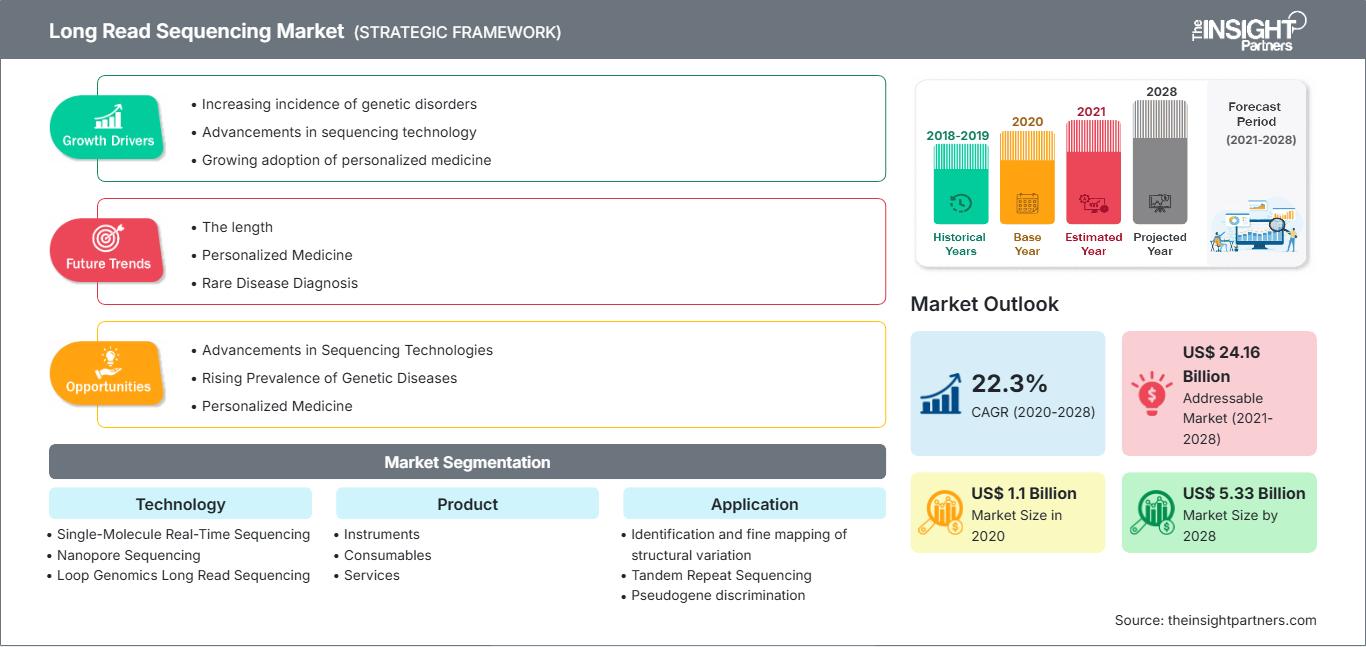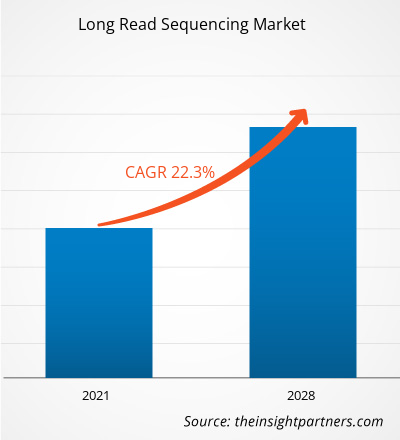Il mercato del sequenziamento a lettura lunga è stato valutato a 1.101,15 milioni di dollari nel 2020 e si prevede che raggiungerà i 5.334,68 milioni di dollari entro il 2028; si prevede una crescita a un CAGR del 22,3% tra il 2021 e il 2028.
Il sequenziamento a lettura lunga è una tecnica di sequenziamento del DNA. Offre numerosi vantaggi rispetto alle tecnologie di sequenziamento di nuova generazione, come la possibilità di sequenziare con maggiore precisione il DNA contenente le stesse sezioni di DNA ripetute all'interno del genoma. Molti adulti di età pari o superiore a 60 anni soffrono di due o più malattie croniche. Secondo una ricerca sui gemelli, i geni svolgono un ruolo in malattie croniche come malattie cardiovascolari, diabete, obesità, artrite reumatoide, morbo di Alzheimer (AD) e depressione. Secondo i Centers for Disease Control and Prevention (CDC), circa 6 individui su 10 negli Stati Uniti sono affetti da almeno una malattia cronica, mentre 4 su 10 soffrono di due o più malattie croniche. Inoltre, il cancro è causato principalmente da errori genomici. I ricercatori hanno analizzato i genomi tumorali utilizzando una varietà di tecnologie di sequenziamento in rapida evoluzione per comprendere meglio lo stato molecolare delle cellule tumorali ed evidenziarne le vulnerabilità, come le mutazioni driver o l'espressione genica. I ricercatori sono stati in grado di riconoscere e classificare nuove forme di mutazioni tumorali utilizzando tecnologie a lettura lunga, incluse varianti strutturali complesse nella risoluzione degli aplotipi. Negli ultimi anni, sono state sviluppate e utilizzate diverse tecnologie di sequenziamento a lettura lunga. Ad esempio, Pacific Biosciences ha sviluppato il sequenziamento SMRT, che è uno dei metodi a lettura lunga (PacBio). Il sequenziamento a lettura lunga sta diventando sempre più comune e gli studi sul cancro basati su dati a lettura lunga stanno crescendo e progredendo per decodificare genomi tumorali complessi.
Personalizza questo rapporto in base alle tue esigenze
Potrai personalizzare gratuitamente qualsiasi rapporto, comprese parti di questo rapporto, o analisi a livello di paese, pacchetto dati Excel, oltre a usufruire di grandi offerte e sconti per start-up e università
Mercato del sequenziamento di letture lunghe: Approfondimenti strategici

-
Ottieni le principali tendenze chiave del mercato di questo rapporto.Questo campione GRATUITO includerà l'analisi dei dati, che vanno dalle tendenze di mercato alle stime e alle previsioni.
Approfondimenti di mercato: i vantaggi del sequenziamento a lettura lunga guidano il mercato del sequenziamento a lettura lunga
Le tecnologie a lettura lunga stanno superando i limiti iniziali di accuratezza e produttività e stanno ampliando la loro applicazione nei campi della genomica. Il sequenziamento a lettura lunga, o sequenziamento di terza generazione, offre diversi vantaggi rispetto al sequenziamento a lettura corta. Mentre i sequenziatori a lettura corta come gli strumenti HiSeq, NovaSeq, NextSeq e MiSeq di Illumina, i modelli MGISEQ e BGISEQ di BGI o i sequenziatori Ion Torrent di Thermo Fisher producono letture fino a 600 basi, le tecnologie di sequenziamento a lettura lunga generano regolarmente letture superiori a 10 kb. Inoltre, le letture lunghe possono migliorare l'assemblaggio de novo, la certezza della mappatura, l'identificazione delle isoforme dei trascritti e il rilevamento di varianti strutturali. Inoltre, il sequenziamento a lettura lunga di molecole native, ovvero DNA e RNA, elimina il bias di amplificazione preservando al contempo le modifiche di base. Grazie ai continui progressi in termini di accuratezza, produttività e riduzione dei costi, queste funzionalità hanno iniziato a rendere il sequenziamento a lettura lunga un'opzione per un'ampia gamma di applicazioni in genomica per organismi modello e non modello.
Tecnologia: Approfondimenti
Il mercato globale del sequenziamento a lettura lunga, in base alla tecnologia, è segmentato in sequenziamento in tempo reale a singola molecola (SMRT), sequenziamento a nanopori e sequenziamento a lettura lunga con genomica a loop. Il segmento del sequenziamento in tempo reale a singola molecola (SMRT) ha detenuto la quota di mercato maggiore nel 2020. Tuttavia, si prevede che il segmento del sequenziamento a lettura lunga con genomica a loop registrerà il CAGR più elevato sul mercato durante il periodo di previsione.Approfondimenti regionali sul mercato del sequenziamento a lettura lunga
Le tendenze regionali e i fattori che influenzano il mercato del sequenziamento di letture lunghe durante il periodo di previsione sono stati ampiamente spiegati dagli analisti di The Insight Partners. Questa sezione illustra anche i segmenti e la geografia del mercato del sequenziamento di letture lunghe in Nord America, Europa, Asia-Pacifico, Medio Oriente e Africa, America meridionale e centrale.
Ambito del rapporto di mercato sul sequenziamento di lunga lettura
| Attributo del rapporto | Dettagli |
|---|---|
| Dimensioni del mercato in 2020 | US$ 1.1 Billion |
| Dimensioni del mercato per 2028 | US$ 5.33 Billion |
| CAGR globale (2020 - 2028) | 22.3% |
| Dati storici | 2018-2019 |
| Periodo di previsione | 2021-2028 |
| Segmenti coperti |
By Tecnologia
|
| Regioni e paesi coperti |
Nord America
|
| Leader di mercato e profili aziendali chiave |
|
Long Read Sequencing Market Players Density: comprendere il suo impatto sulle dinamiche aziendali
Il mercato del sequenziamento di letture lunghe è in rapida crescita, trainato dalla crescente domanda degli utenti finali, dovuta a fattori quali l'evoluzione delle preferenze dei consumatori, i progressi tecnologici e una maggiore consapevolezza dei vantaggi del prodotto. Con l'aumento della domanda, le aziende stanno ampliando la propria offerta, innovando per soddisfare le esigenze dei consumatori e sfruttando le tendenze emergenti, alimentando ulteriormente la crescita del mercato.

- Ottieni il Mercato del sequenziamento di letture lunghe Panoramica dei principali attori chiave
Per tecnologia
- Sequenziamento in tempo reale a singola molecola (SMRT)
- Sequenziamento a nanopori
- Sequenziamento a lettura lunga con loop genomico
Per prodotto
- Strumenti
- Materiali di consumo
- Servizi
Per applicazione
- Identificazione e mappatura fine della variazione strutturale
- Sequenziamento a ripetizione in tandem
- Discriminazione di pseudogeni
- Risoluzione della fase allelica
- Riproduttiva Genomica
- Cancro
- Sequenziamento virale e microbico
- Altro
Per flusso di lavoro
- Pre-sequenziamento
- Sequenziamento
- Analisi dei dati
Per utente finale
- Istituti di ricerca accademica
- Ospedali e cliniche
- Aziende farmaceutiche e biotecnologiche
Per area geografica
-
Nord America
- Stati Uniti
- Canada
- Messico
-
Europa
- Francia
- Germania
- Italia
- Regno Unito
- Spagna
-
Asia Pacifico
- Cina
- India
- Corea del Sud
- Giappone
- Australia
-
Medio Oriente e Africa
- Sudafrica
- Arabia Saudita
- Emirati Arabi Uniti
-
America meridionale e centrale
- Brasile
- Argentina
Profili aziendali
- Oxford Nanopore Technologies
- Tataa Biocenter
- Illumina, Inc
- Perkinelmer Inc.
- F. Hoffmann-La Roche Ltd.
- Baseclear BV
- Bionano Genomics
- Longas Technologies
- Pacific Biosciences of California, Inc.
- Quantapore, Inc.
- Analisi storica (2 anni), anno base, previsione (7 anni) con CAGR
- Analisi PEST e SWOT
- Valore/volume delle dimensioni del mercato - Globale, Regionale, Nazionale
- Industria e panorama competitivo
- Set di dati Excel
Report recenti
Testimonianze
Motivo dell'acquisto
- Processo decisionale informato
- Comprensione delle dinamiche di mercato
- Analisi competitiva
- Analisi dei clienti
- Previsioni di mercato
- Mitigazione del rischio
- Pianificazione strategica
- Giustificazione degli investimenti
- Identificazione dei mercati emergenti
- Miglioramento delle strategie di marketing
- Aumento dell'efficienza operativa
- Allineamento alle tendenze normative






















 Ottieni un campione gratuito per - Mercato del sequenziamento di letture lunghe
Ottieni un campione gratuito per - Mercato del sequenziamento di letture lunghe